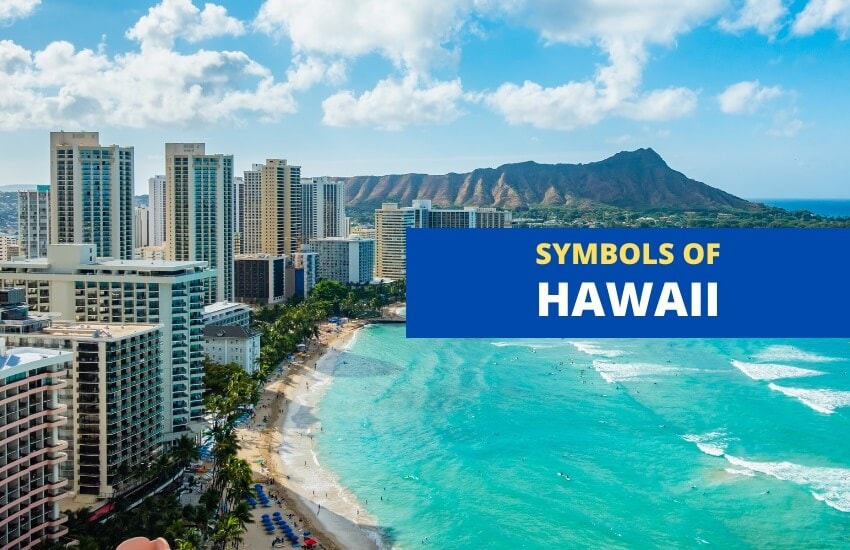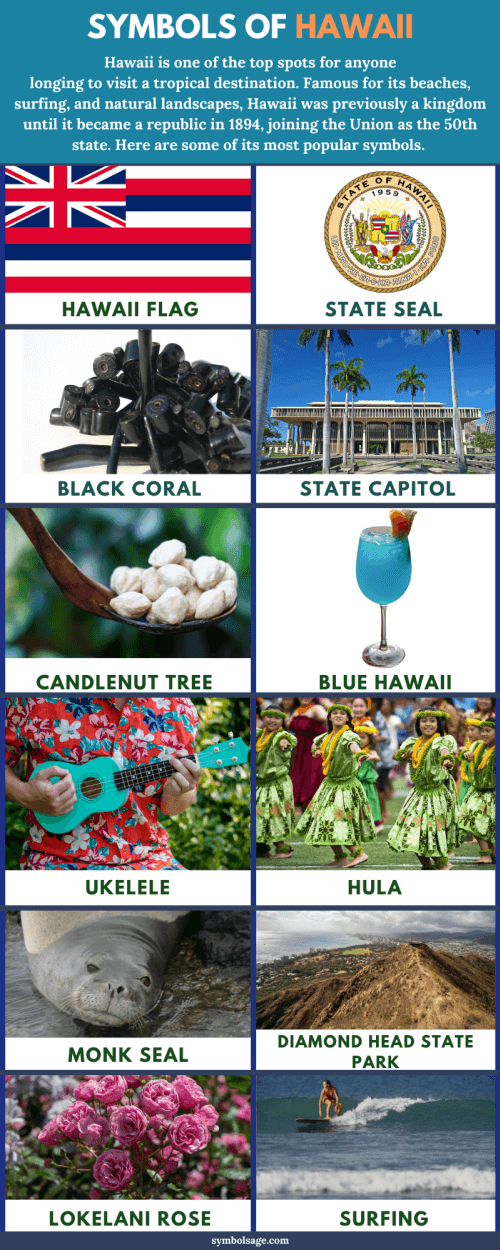
Table of Contents
Hawaii is one of the best places in America for anyone longing to visit a tropical destination. Famous for some of the best surfing spots on the planet and its breathtaking beauty, Hawaii was previously a kingdom until it became a republic in 1894. In 1898, it ceded itself to the United States of America, was admitted to the union and became the 50th state of the U.S.
There are many important state symbols of Hawaii, some of which are more globally popular while others may be more obscure. However, all of them are unique in their own way. Let’s take a quick look.

The Flag of Hawaii
The state flag of Hawaii consists of the Union Jack of the UK in its top quarter closest to its mast. The rest of the flag is composed of eight white, blue and red horizontal stripes that follow the same sequence from top to bottom, representing the 8 major islands of the state. The flag symbolizes the status of Hawaii as a territory, republic and kingdom as well as its present position as one of the official states of the U.S. It’s the only state flag in the U.S. that includes the national flag of a foreign country, because many of the Hawaiian King Kamehameha’s advisors were from Great Britain.
State Seal of Hawaii
The Great Seal of Hawaii features an image of King Kamehameha I, holding his staff, and Liberty holding the flag of Hawaii. Both figures stand on either side of a shield. The two figures symbolize the old government leader (King Kamehameha) and the new leader (Lady Liberty).
At the bottom is a Phoenix rising up from the native foliage, symbolizing death, resurrection and the transition from an absolute monarchy to a democratic government. The foliage around the phoenix are typical flora of Hawaii and represent the eight main islands.
The seal was officially adopted by the Territorial Legislature in 1959 and is used by the Illinois government on official documents and legislations.
Hawaii State Capitol
Located in Honolulu, the State Capitol of Hawaii was dedicated and commissioned by the state’s second Governor John A. Burns. It was officially opened in March 1969, replacing the Iolani Palace which was the former statehouse.
The Capitol is built in such a way as to allow sun, rain and wind to enter in and each of its distinct architectural features represents the various natural aspects of the state. Its principle tenants are the Lieutenant Governor of Hawaii and the Governor of Hawaii and all duties involved in the governance of the state are performed in its many chambers.
Muumuu and Aloha
The Muumuu and Aloha are the traditional Hawaiian clothes worn by women and men respectively. The muumuu is a loose dress that’s a little like a cross between a robe and a shirt, hanging from the shoulder. Muumuus are popular maternity wear because they’re free-flowing and don’t restrict at the waist. They’re also worn for weddings and at festivals. The Aloha shirts are collared and buttoned, typically short-sleeved and cut out from printed fabric. Not only are they casual wear, but they’re also worn as informal business attire.
Blue Hawaii
Created in 1957 by bartender Harry Yee, Blue Hawaii is a tropical cocktail made by blending equal parts vodka, rum, pineapple juice and Blue Curacao. Yee came up with the drink after experimenting with several variations of Curacao liqueur and named it ‘Blue Hawaii’ after Elvis Presley’s movie of the same name. Typically served on the rocks, Blue Hawaii is the signature drink of Hawaii.
Candlenut Tree
The candlenut (Aleurites moluccanus) is a flowering tree which grows throughout the Old and New World tropics. Also known as ‘Kukui’, it grows to about 25m in height and has wide, pendulous branches with pale green leaves. The seed of the nut is white, oily and fleshy and serves as a source of oil. The nut is often eaten cooked or toasted and a Hawaiian condiment called ‘inamona’ is made by roasting the nut and mixing it into a thick paste with salt. The candlenut was designated as the state tree of Hawaii in 1959 because of its many uses.
The Hula
The Hula dance is a form of Polynesian dance that was developed in Hawaii by the Polynesian who settled there originally. It’s a complex form of dance that involves the use of many hand motions to represent the lyrics in a song or a chant. There are several different types of hula dances are most are considered to be religious performances, dedicated to or honoring a Hawaiian god or goddess. Named the state dance of Hawaii in 1999, the modern hula dance is performed to historical chants.
The Ukulele
The ukulele (also called pahu) is a small, stringed instrument similar to a guitar, brought to Hawaii by Portuguese immigrants. It became incredibly popular throughout the United States in the early twentieth century and began to spread internationally.
The ukulele is now an important part of Hawaiian culture and music thanks to its promotion and support by King Kalakaua. Being a patron of the arts, the king incorporated the ukulele into performance at all royal gatherings. As a result, it became strongly associated with Hawaii and was designated as the official modern musical instrument of the state in 2015.
Hawaiian Monk Seal (Neomonachus schauinslandi)
The Hawaiian monk seal is a species of seal endemic to the Islands of Hawaii and named an official mammal symbol of the state. It has a white belly, grey coat and slender physique which is perfect for hunting prey. When it’s not busy eating and hunting, the seal typically basks on the volcanic rock and sandy beaches of the Northwest Hawaiian Islands. The monk seal is currently endangered but due to conservation projects that are being carried out, the seal population is slowly recovering. It’s now illegal to capture, harass or kill a Hawaiian monk seal and anyone who does so will face serious consequences.
Diamond Head State Park
A volcanic cone located on the island of Oahu, Diamond Head is the most popular state park of Hawaii. In the 19th century, British soldiers who had visited the area thought that the calcite crystals on the beach were diamonds because of their shine and sparkle.
Diamond Head is a part of the Ko’olau volcanic range that began to erupt over 2.6 million years ago below sea level. When it erupted about 300,000 years ago, it created the crater known as a tuff cone. Luckily, it’s monogenetic, meaning that it erupts only once.
Lokelani Rose
The lokelani rose, also called the ‘Maui rose’, is a beautiful flower with a heavenly fragrance for which it’s well renowned. These flowers are harvested to make rose oil used in perfumery and to make rose water as well. Lokelani petals are edible and can be used to flavour food, as a herbal tea or as a garnish. The plant is a deciduous shrub which grows about 2.2 metres tall and stems are armed with curved, stout prickles. Introduced to Hawaii in the 1800s, lokelani is now recognized as the official state flower of Hawaii.
Surfing
Surfing, a highly popular sport throughout the world was designated as the official individual sport of the state of Hawaii in 1998. The ancient Hawaiians didn’t consider surfing to be a hobby, career, recreational activity of extreme sport as its’ viewed today. Instead, they integrated it into their culture and made it more of an art. There are numerous surfing spots throughout the Hawaiian Islands that attract modern surfers, making them great tourist attractions.
Black Corals
Black corals, also known as ‘thorn corals’, are a type of soft, deep-water corals characterized by their pitch-black or dark brown skeletons made of chitin. Named the state gem of Hawaii in 1986, the black coral has been harvested for hundreds of years as a medicine and charm. The Hawaiians believed that it has the power to ward of the evil eye and injury and they ground it into powder for medicinal purposes. Today, their beliefs remain the same and the popularity of the black coral has continued to increase.
Hawaiian Hoary Bat
Endemic to the Hawaiian Islands, the Hawaiian hoary bat was named the state land mammal in 2015. Hoary bats are brownish and can be easily distinguished by a silver color that looks like frost on their back, ears and neck. They’re currently listed as endangered due to habitat loss, the impact of pesticides and collisions with structures made by humans.
The Hawaiian hoary bat is considered unique and valuable since it plays an important role in its environment. Therefore, strict measures are being taken to protect the creature from the threat of extinction.
Aloha Festivals
The Aloha Festivals are a series of cultural celebrations that take place annually in the state of Hawaii. The festivals began in 1946 as the Hawaiian’s way of celebrating and bringing out their culture after the war. Each year around 30,000 people volunteer to provide labor, plan and organize the Aloha Festivals and their efforts are made to entertain well over 1,000,000 people from all corners of the state as well as from all over the world. The festivals continue to be held annually in the spirit of preserving the Hawaiian heritage and culture rather than as a way of making money.
Check out our related articles on other popular state symbols:
Symbols of California








